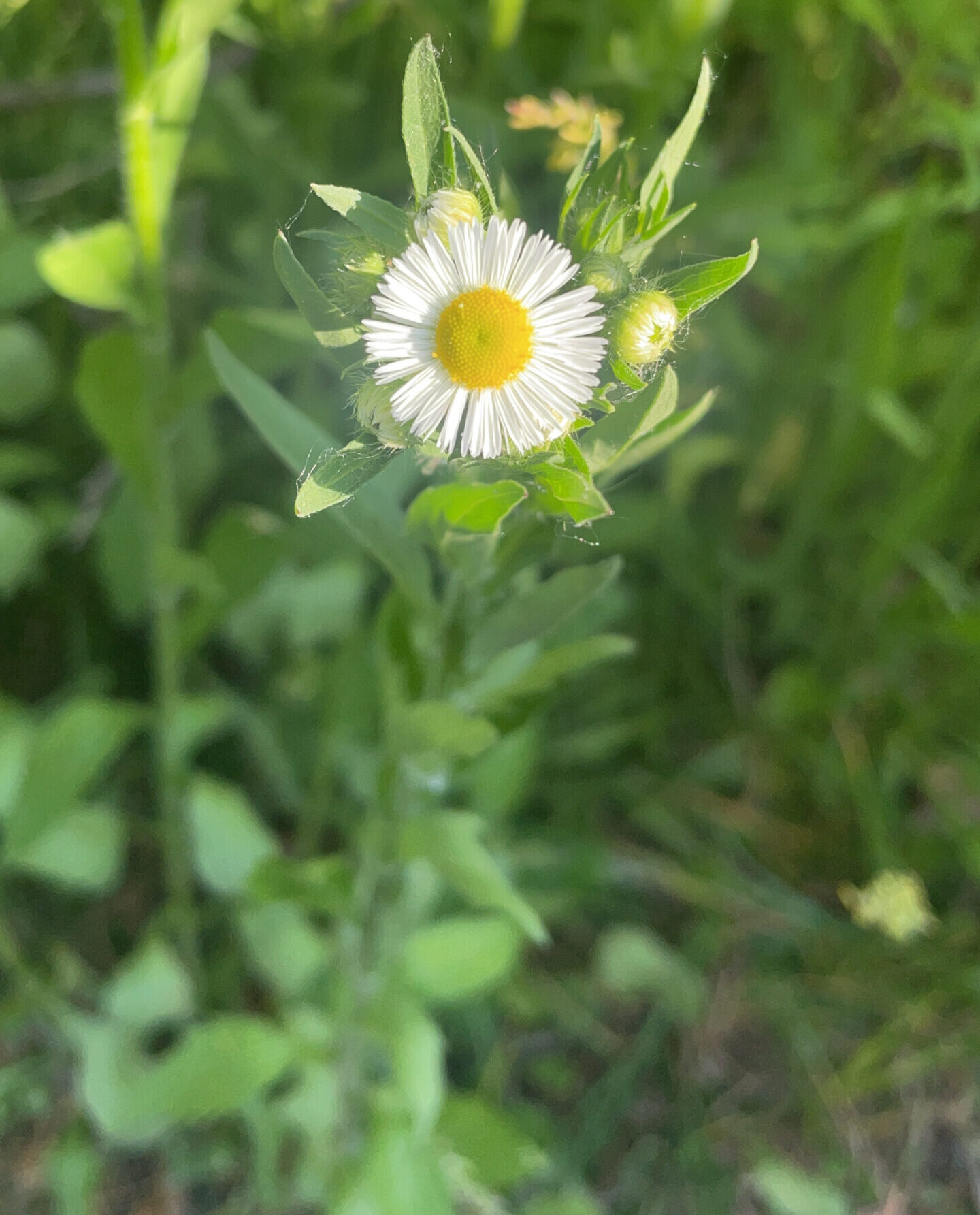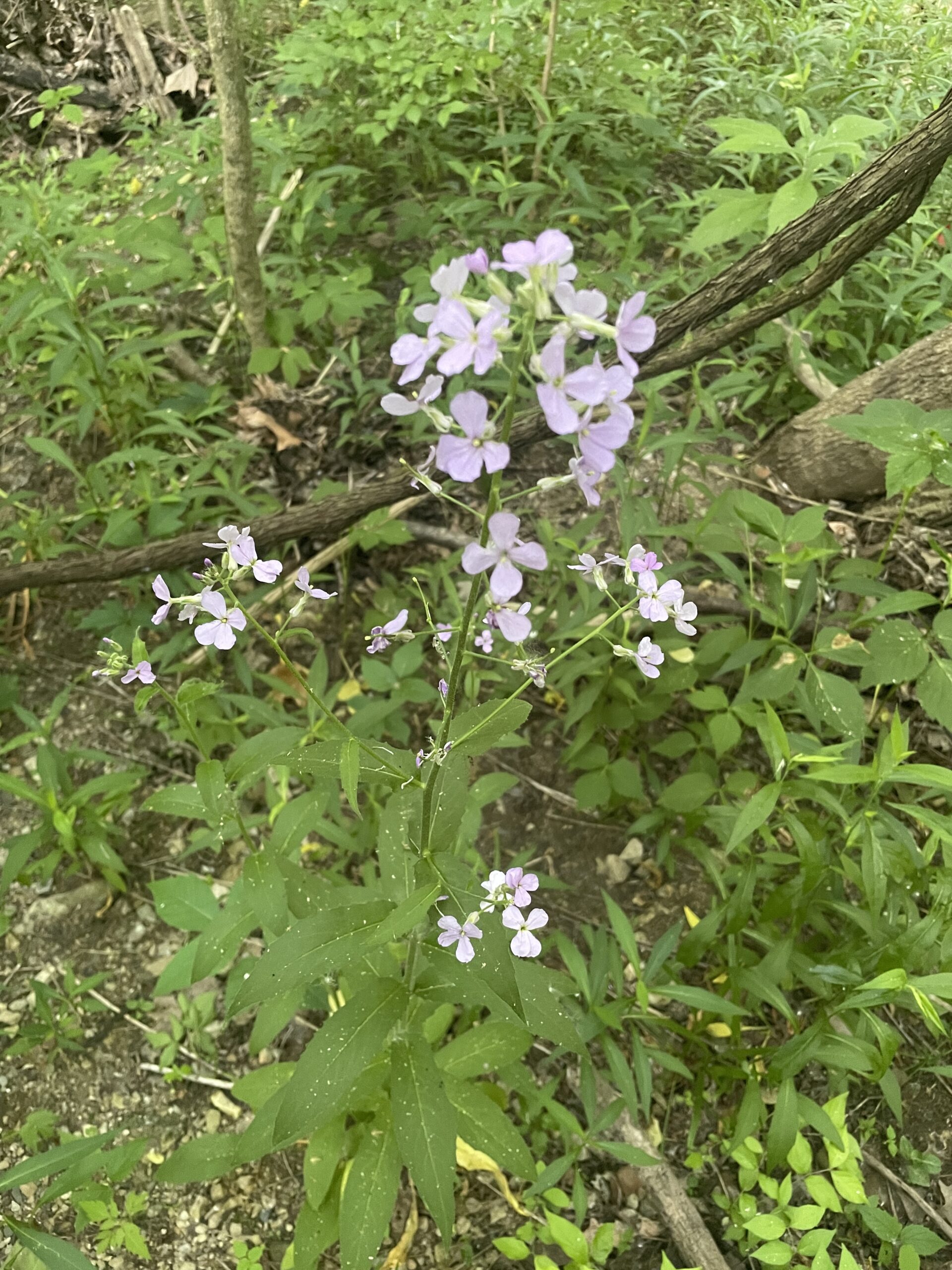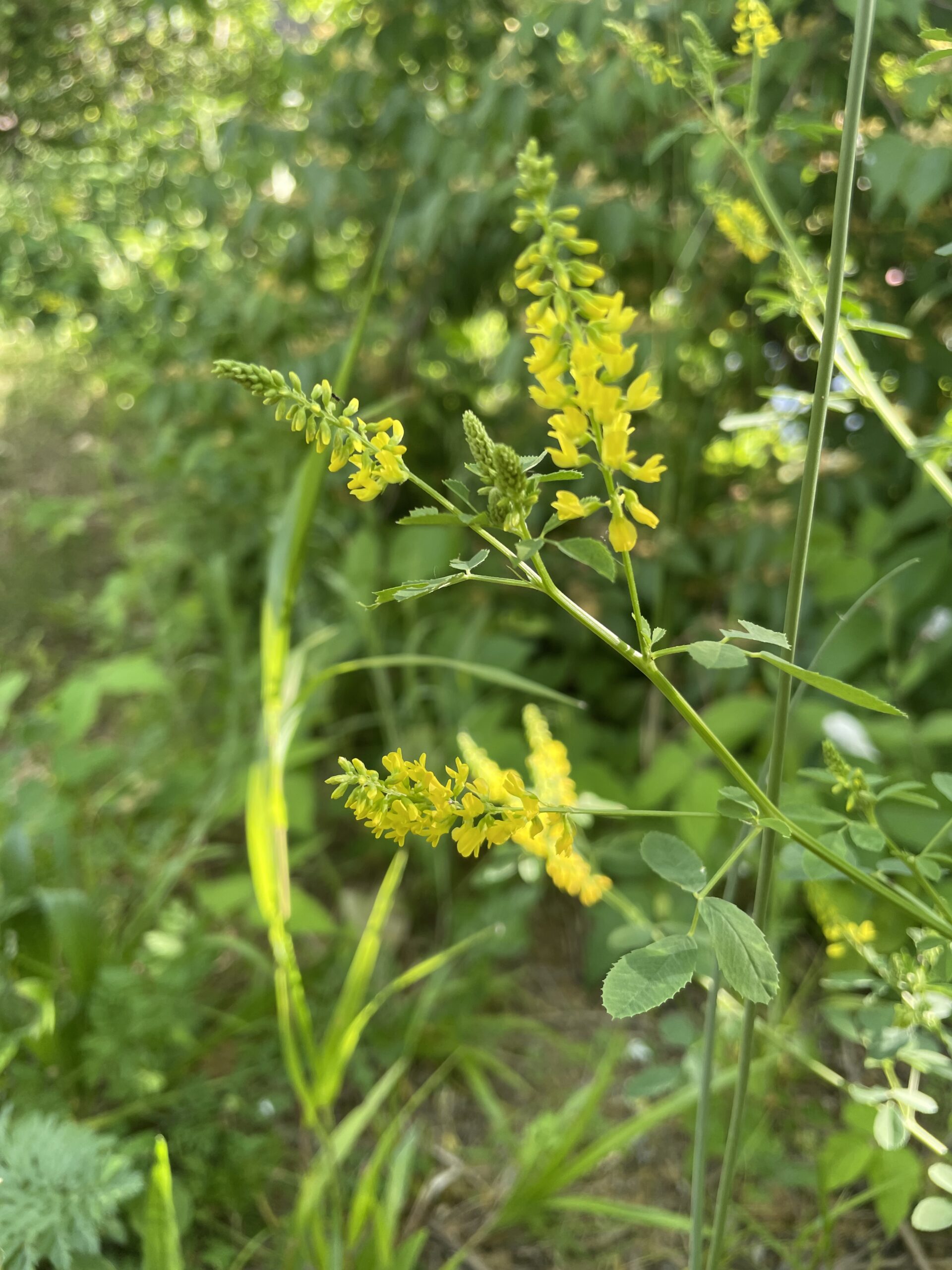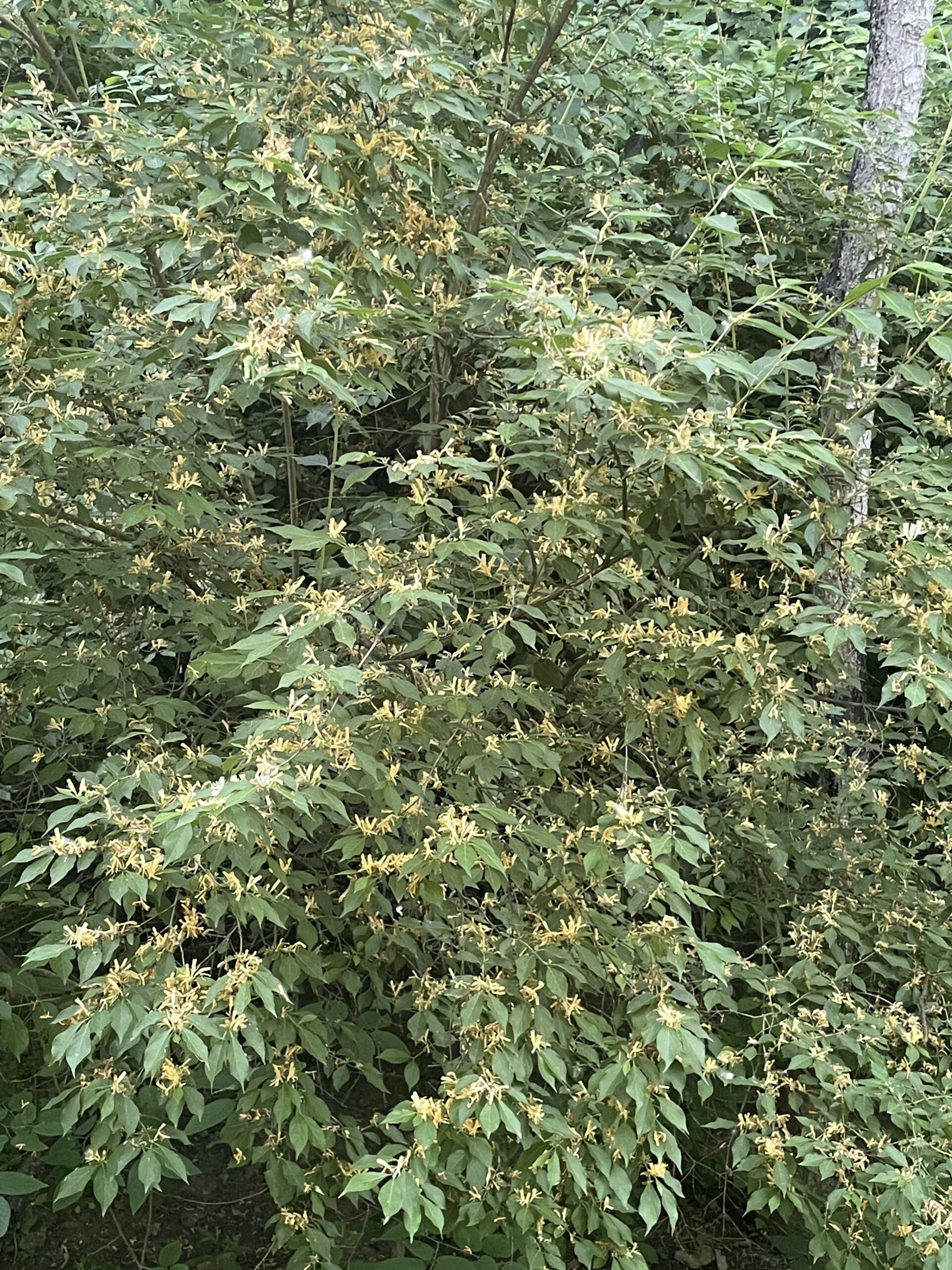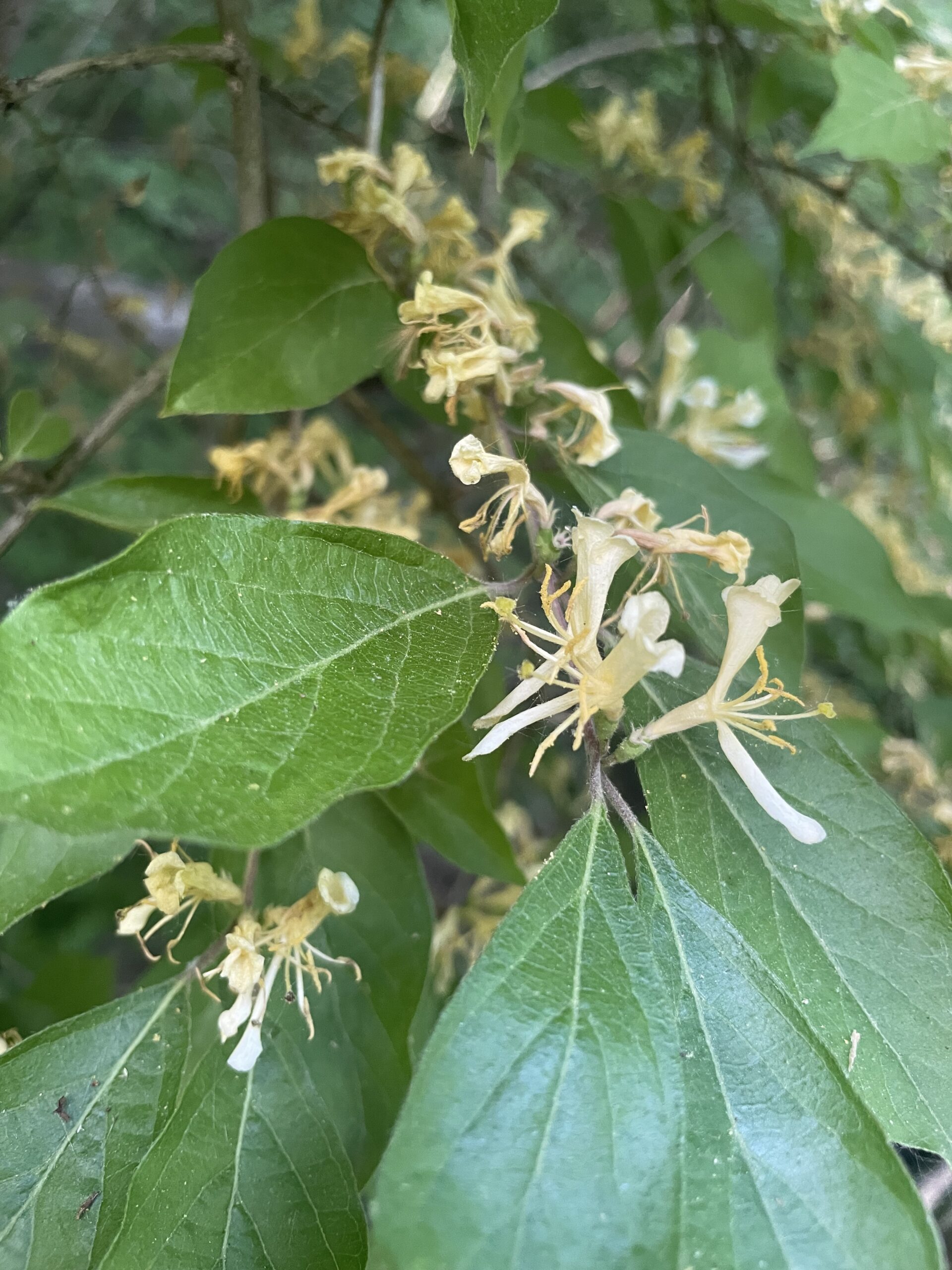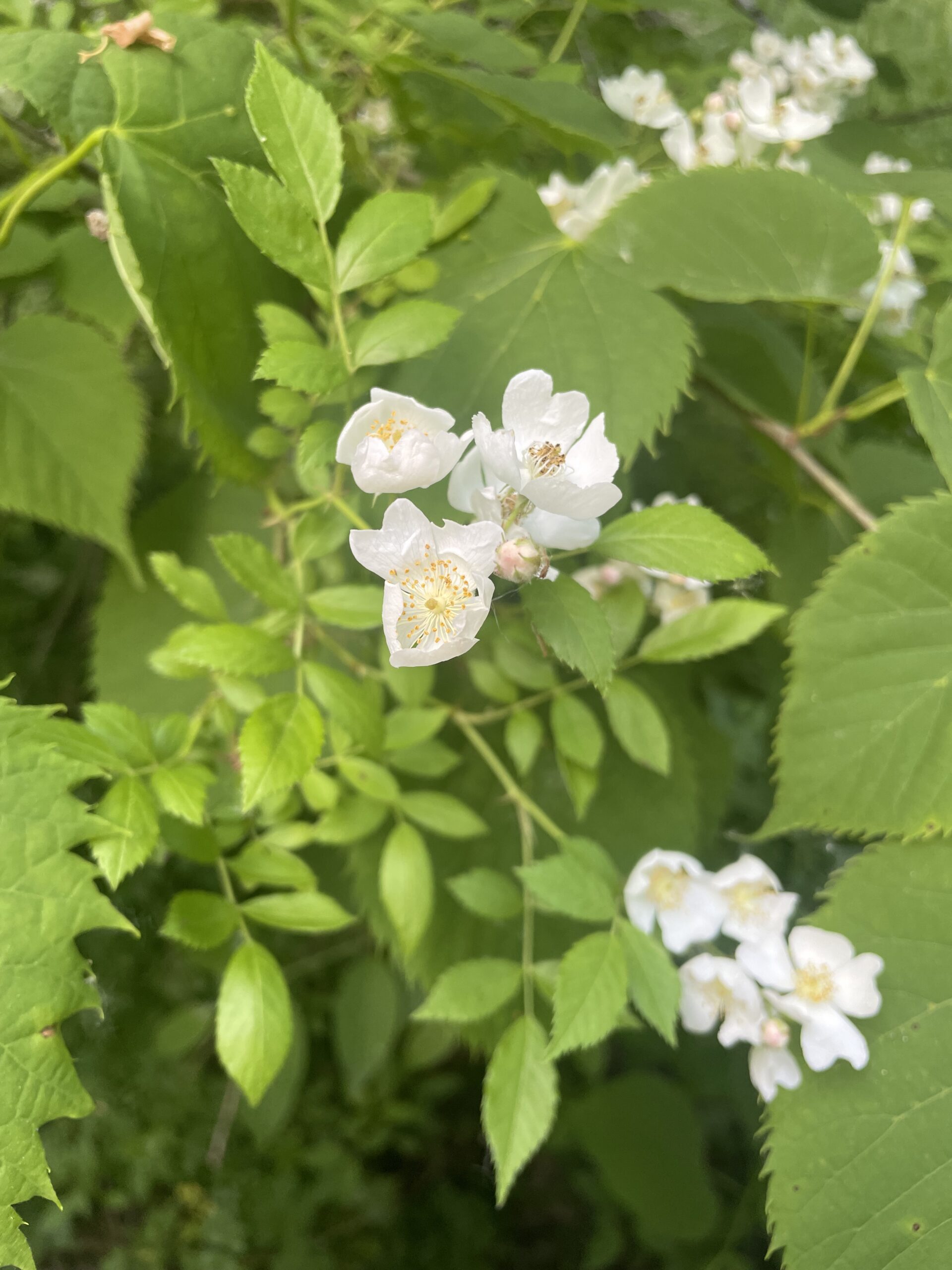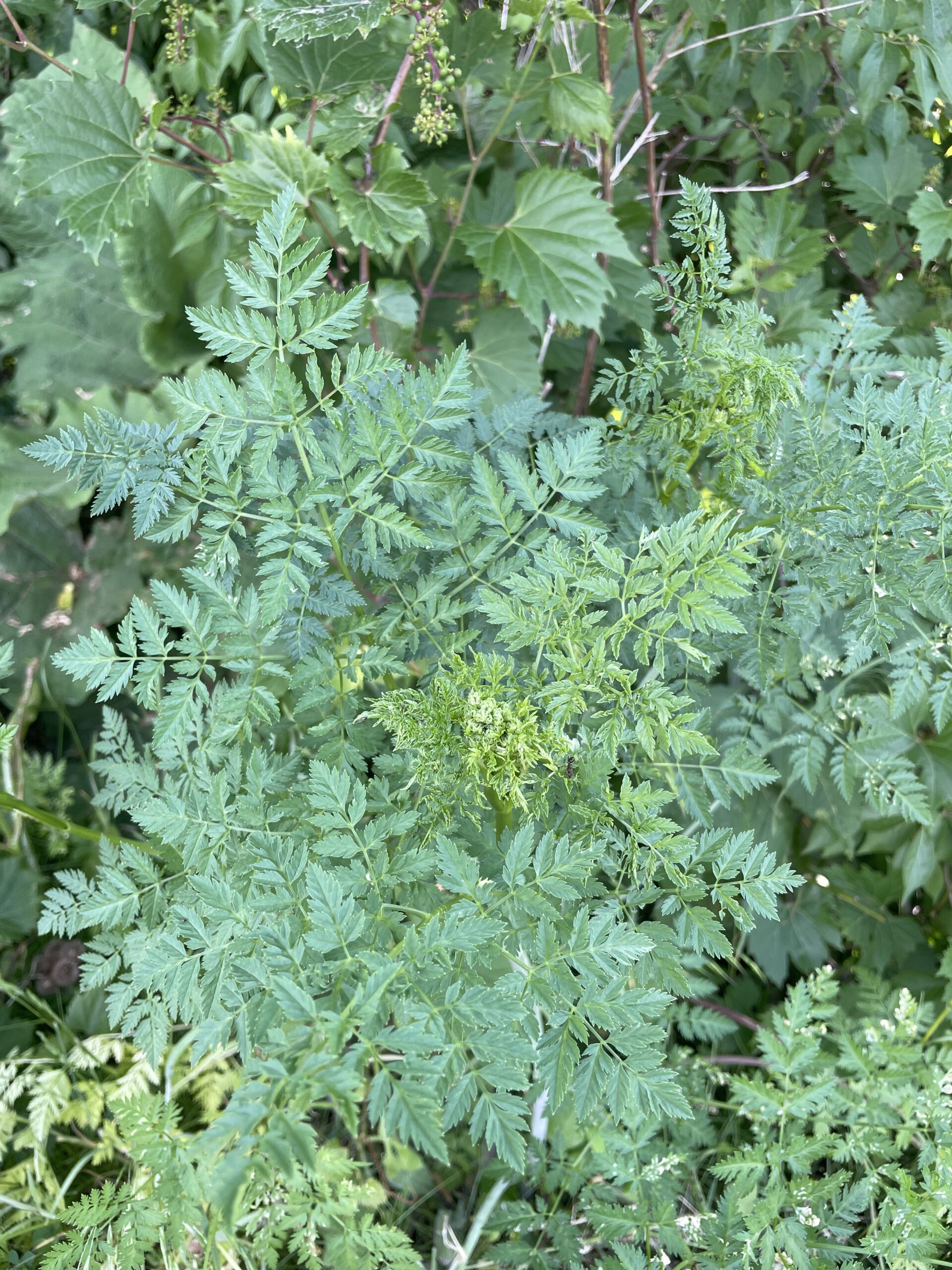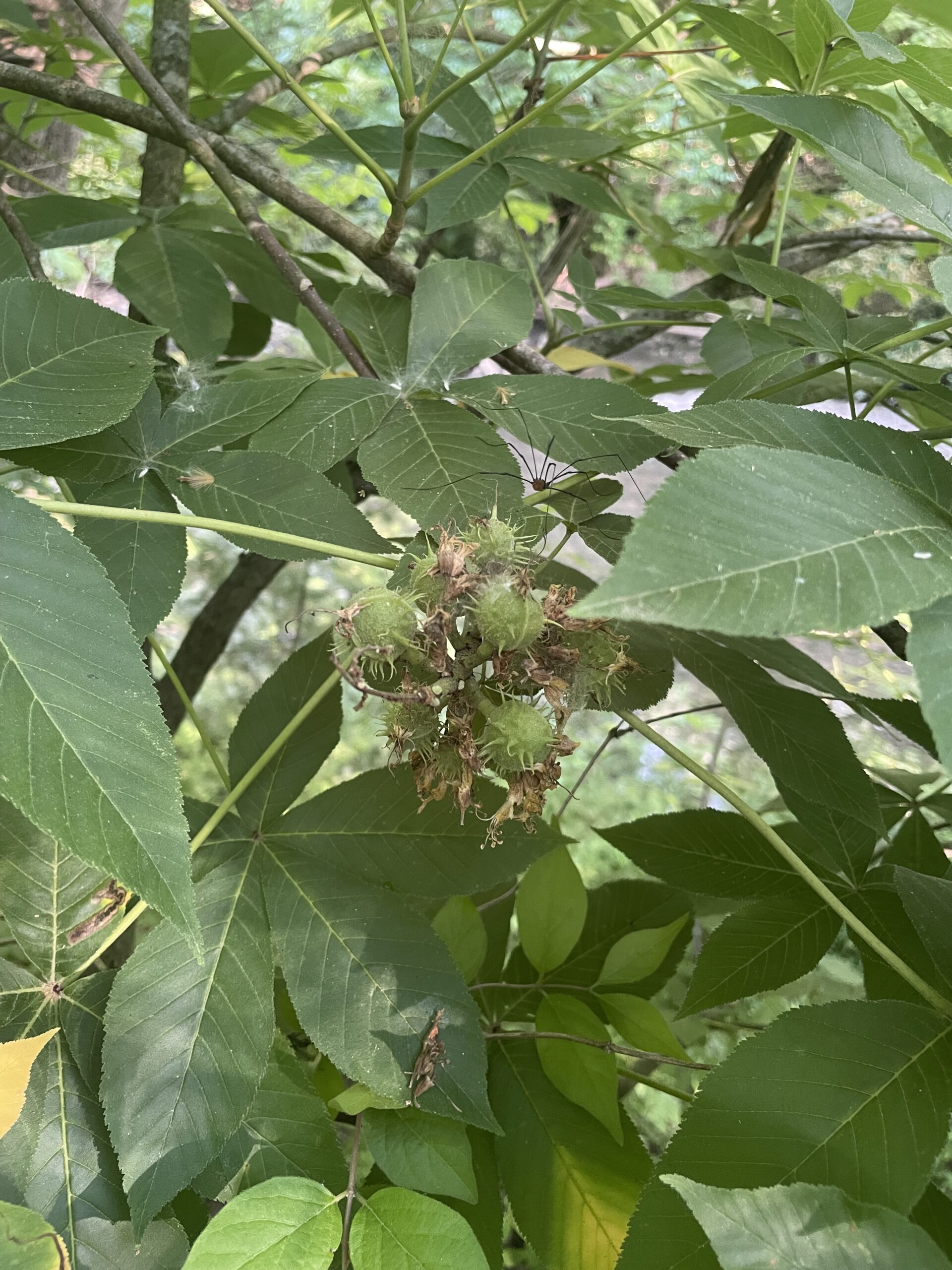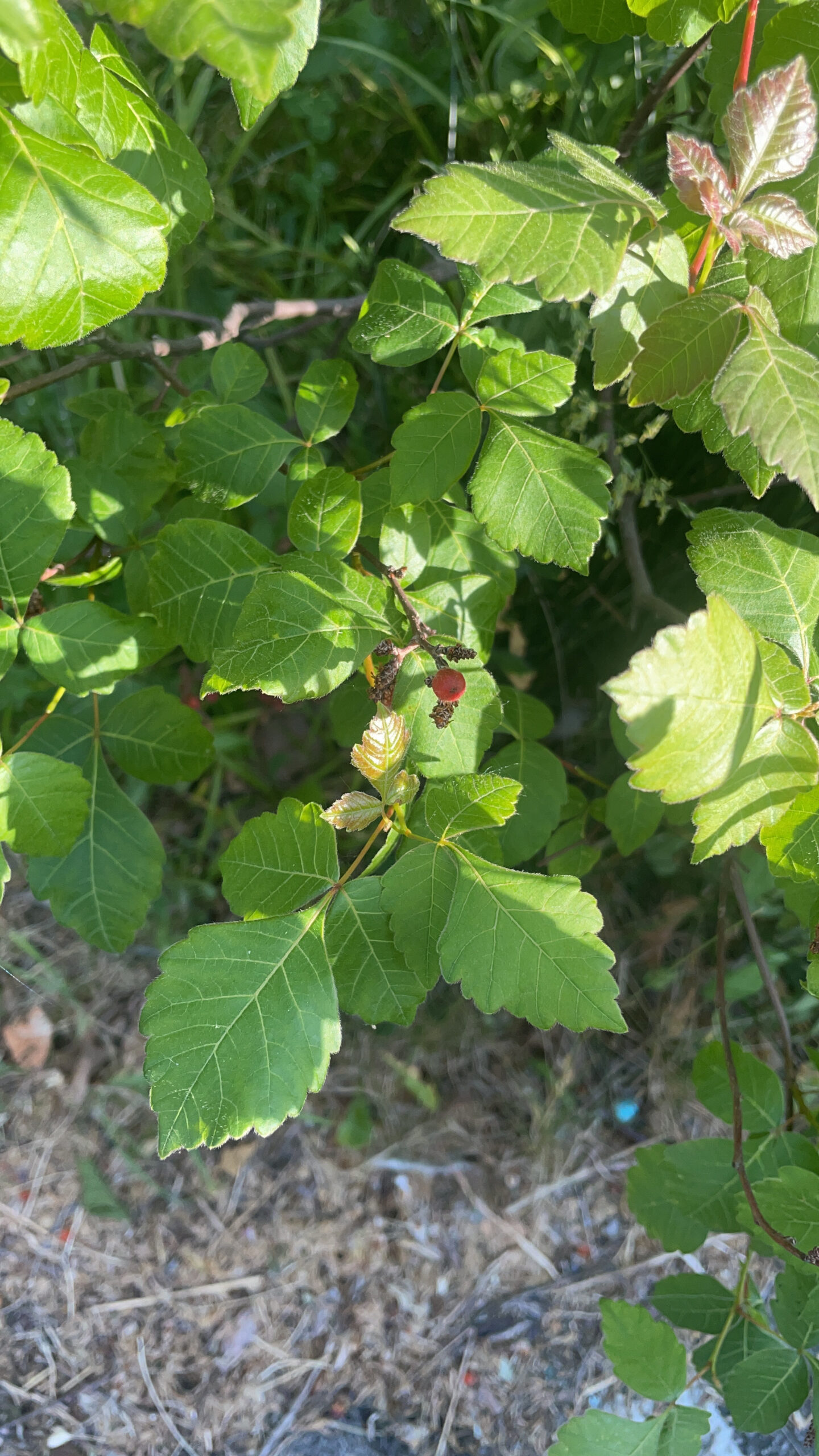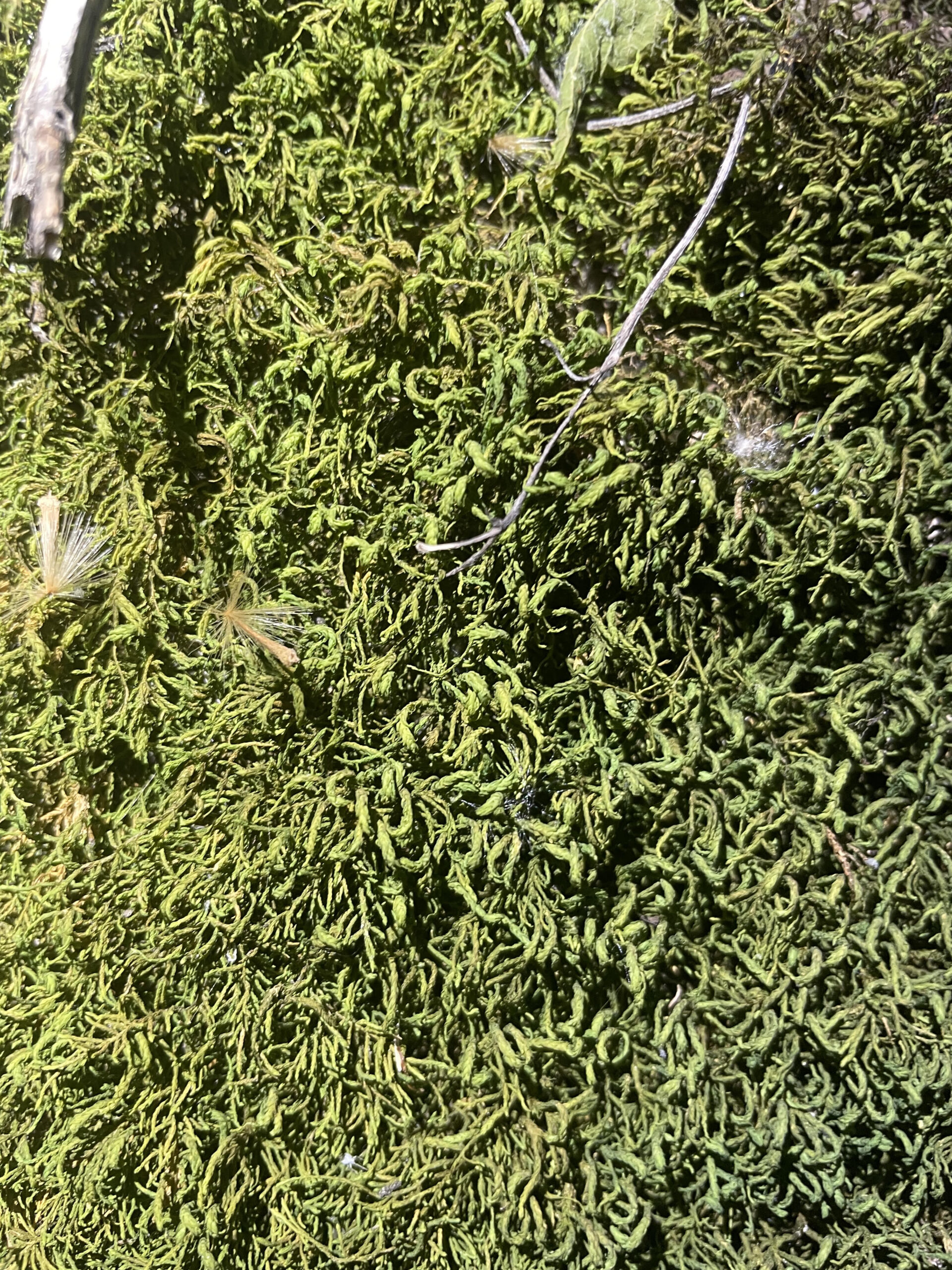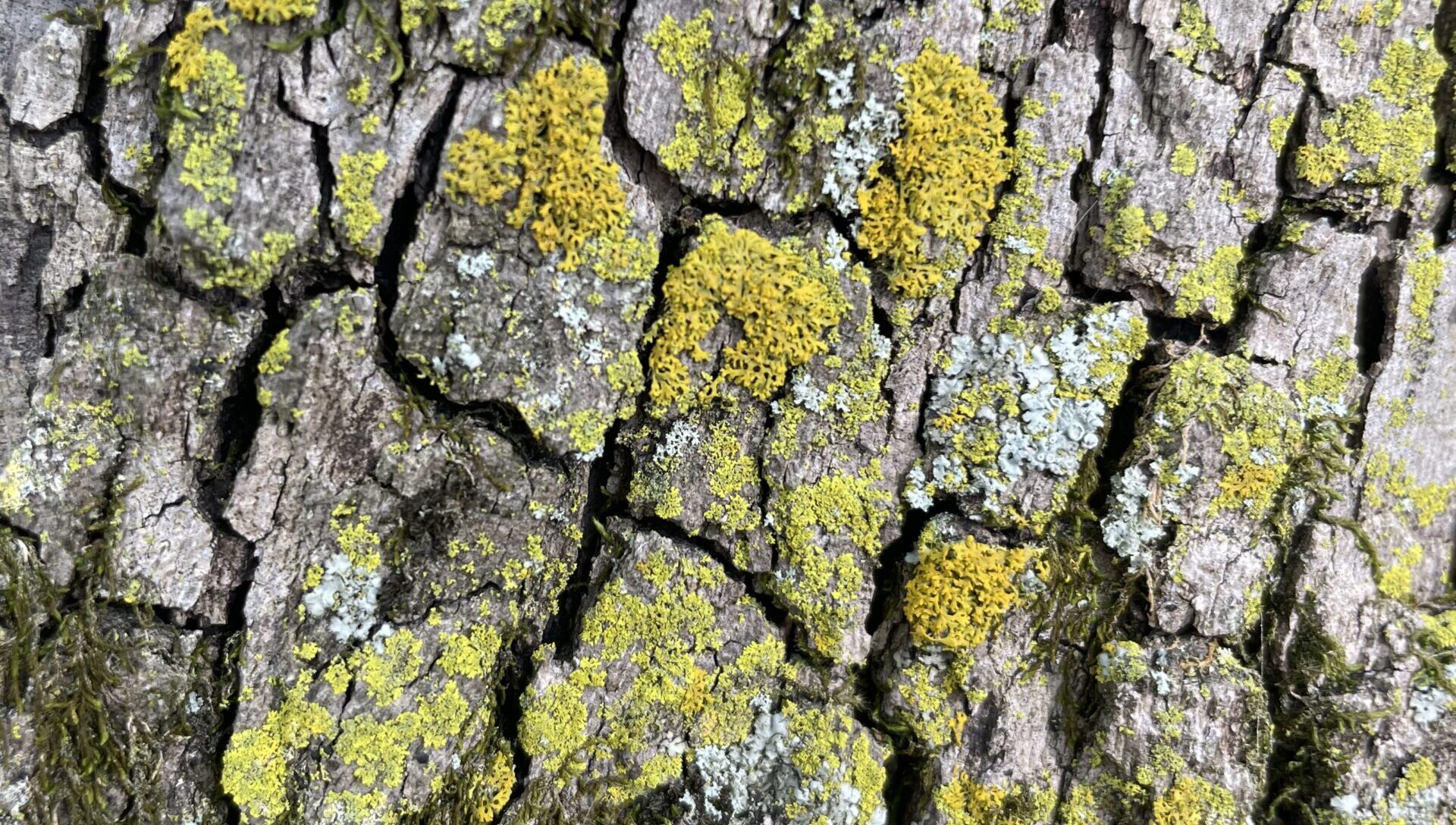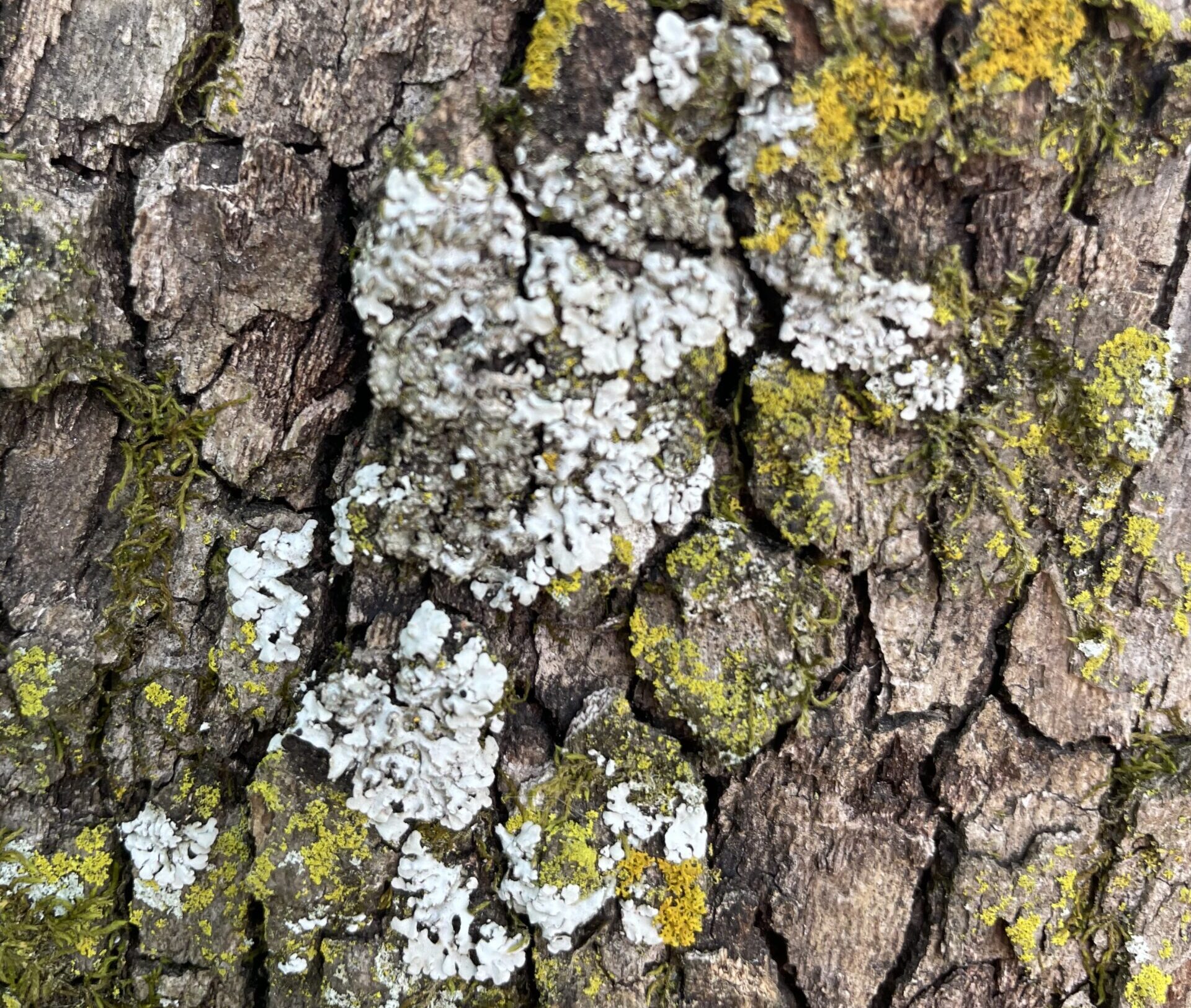Description of the Survey Sites
 A map showing the survey site and trail path at Griggs Reservoir.
A map showing the survey site and trail path at Griggs Reservoir.
This portion of the study site is a recreational park located on Riverside Drive in Dublin Ohio called Griggs Reservoir. The park runs North from Griggs Dam, following along the Scioto River to Lane Road on the East side of the reservoir. In the picture above, you can see a blue path line which highlights the trail I surveyed. It was approximately 1,228 meters and followed along the Scioto River. It is a very well-developed park with many facilities including a boat launch, picknick tables, a playground, shelter houses, an event center, etc.. However, there are paths of lush greenery that separate the trail from the river and there were many spacious open land areas with an abundance of trees.
The second portion of the study sight was at Hayden Falls Park, which is located within the Griggs Nature Preserve, on the West side of the Scioto River along Hayden Run Road just West of the reservoir. I was able to easily access the area from a separate parking lot for Griggs Nature Preserve located on Hayden Run Road. It is a unique limestone gorge that spans about 2 acres with a boardwalk leading back to a serene 35-foot waterfall. The area is not as developed as the reservoir park and had very deep, lush greenery along high cliffs. To locate most of my plant species, I did trail off the boardwalk getting closer near the river’s edge (shown on the right in map below), which was also thriving with plant and animal wildlife.
A map showing Hayden Run park within Griggs Nature Preserve.
Poison-Ivy Everywhere!
There was a plethora of Poison-Ivy (Toxicodendron radicans) all over the sites I surveyed. This is an extremely important plant to look out for because it causes a terribly itchy rash, that I am sure you are familiar with. It is a common native vine with trifoliate leaves that can resemble Fragrant Sumac and Poison Oak, but there are some ways to successfully identify Poison Ivy. The vine of this plant resembles a hairy rope with aerial rootlets that attach the vine to the tree. In addition, if the fruit is visible, it looks like white berries but they are actually droops. The leaves may be reddish in color but this only occurs in young or dying leaves. I found this big patch of Poison-Ivy growing on a tree along the Hayden Falls boardwalk.
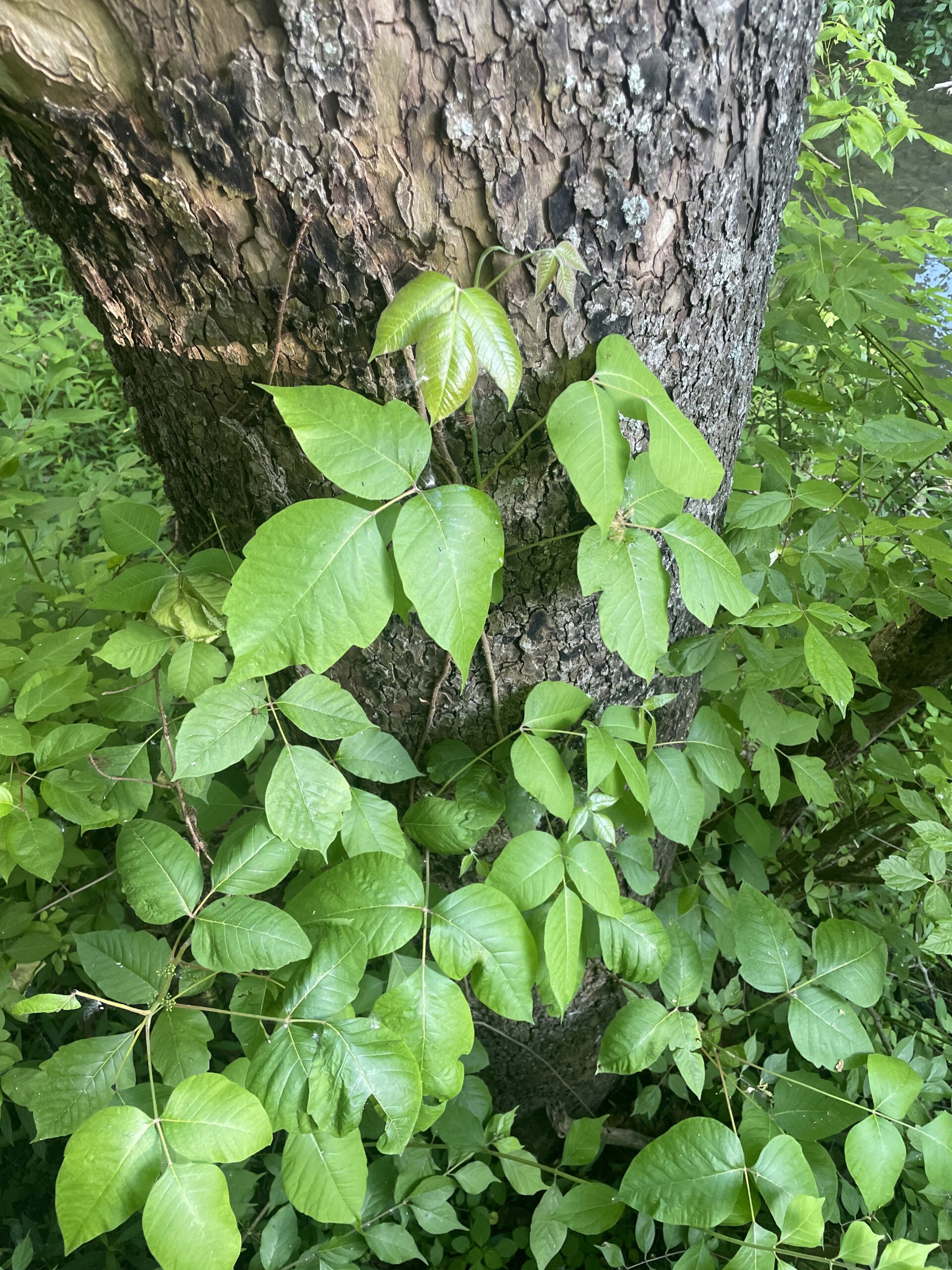 A good amount of Poison-Ivy growing on bark of this tree.
A good amount of Poison-Ivy growing on bark of this tree.
Flowers and Inflorescences
Common Fleabane
A close up shot of the Common Fleabane flower.
Erigeron philadelphicus, or Common Fleabane, is a native flower found growing in large patches within the wooded area of Hayden Falls. These wildflowers are radially symmetrical with heads composed of tiny flowers inserted on a common receptacle. The umbel inflorescence is a head that looks like a single flower with an inferior ovary, making this plant epigynous, having a syncarpous gynoecium, and the fruit type produced is an achene. It is common in open woods and fields in the spring and summer months.
Dames Rocket
A large patch of Dames Rocket in the woods.
This is commonly known as Dames Rocket, Hesperis matronalis, an herbaceous annual perennial growing heavily in the wooded areas. This invasive species has large, conspicuous purple flowers, which can sometimes be pink or white in color, and are very fragrant. Belonging to the Mustard family, this flower is radially symmetric with four regular parts and branches into a raceme inflorescence type. It has a syncarpous gynoecium with 2 united carpels, and the fruit produced is a silique or a silicle. Lastly, the ovary position of Dames Rocket is superior and lacks a hypanthium, making it hypogenous.
Northern Blue Flag
Northern Blue Flag grows near the riverbank.
This next flower is known as the Larger or Northern Blue Flag, Iris versicolor. A native forb, found moderately near the riverbank and stream. This plant produces blueish purple flowers with yellow veining, also about 4 inches wide. This is a radially symmetric flower with 3 regular parts and an inferior ovary, making it epigynous. It contains a syncarpous gynoecium with 3 fused carpels, produces a capsule type of fruit and the inflorescence type is a monochasial cyme (https://gobotany.nativeplanttrust.org/species/iris/versicolor/). It is commonly found in marshes and wet meadows in late spring and early summer months (https://www.britannica.com/plant/Iridaceae).
Yellow Sweet Clover
A good picture of the flowers of Yellow Sweet Clover.
Lastly, is the Yellow Sweet Clover, Melilotus officinalis. I spotted several individuals near the parking lot of Griggs Reservoir. This biennial flowering plant has non-symmetrical, yellow flowers arranged in racemes. It has a unicarpellate gynoecium, a superior ovary, and produces fruit pods called legumes. When crushed or dried, the foliage gives off a freshly mowed hay fragrance.
Invasive Plants
Amur Honeysuckle
Invasive Amur Honeysuckle was everywhere along the boardwalk!
Amur Honeysuckle, Lonicera maackii, is one of the most abundant invasive plants growing along the boardwalk and wooded areas at Hayden Falls. It is a deciduous shrub that ranges from 6-15 feet tall at maturity and produces many pairs of tubular flowers. This plant is native to China, Russian Far East, Korea, and Japan and was introduced into North America around the late 1800’s. They were initially planted widely for wildlife cover and soil erosion control, but its invasive characteristics proved it to be a nuisance. Theses shrubs will outcompete native vegetation as they leaf out earlier and drop their leaves later than native plants. The fruit of Honeysuckle is highly attractive to birds and deer which widely disperses seeds across the landscape. Repeated cutting, mowing and removal of small plants is can be affective at controlling populations, but select herbicides prove to be the most effective (https://www.oipc.info/uploads/5/8/6/5/58652481/1factsheethoneysuckles.pdf)
Multiflora Rose
Multiflora Rose also in abundance all along the boardwalk.
Another highly invasive plant found is the Multiflora Rose, Rosa multiflora. It is a thorny shrub with compound leaves that are divided into 5 to 11 sharply-toothed leaflets. The clusters of conspicuous white and light pink fragrant flowers appear in late spring. It prefers a sunny to semi-shaded habitat that has well-drained soils, however, can tolerate a large range of environments such as fens, roadsides, prairies, etc. Birds are the primary dispersers of Multiflora Rose seeds as they love to eat the bright red fruits called rose hips. It is estimated that an average of a million Multiflora Rose seeds can be produced by one plant in a single year, and the seeds can stay viable in soil for up to twenty years. Smaller individual plants can be removed, making sure to get all the roots out and mowing of large shrubs can give some control. With the application of systemic herbicides, Multiflora Rose is relatively easy to control (https://www.oipc.info/uploads/5/8/6/5/58652481/8factsheetmultiflorarose.pdf).
Poison Hemlock
Poison Hemlock growing near the parking lot.
The next of our invasive species is one of the deadliest plants found in North America, known as Poison Hemlock, Conium maculatum. If you came across this plant, you may think it resembles something from the carrot family (you would be correct!), but do not be fooled into tasting any part of this plant as all are poisonous. The leaves, stems, roots, and seeds all contain highly toxic piperidine alkaloid compounds that cause respiratory failure and even death in mammals. This biennial weed made its way into the United States in the late 1800’s and is native to Europe, West Asia, and North Africa. It has a two-part life cycle where it spends its first year as low-growing basal rosette, and the second year it produces tall, erect stalks with umbrella-like flowers that can get up to 10 feet tall. Poison Hemlock can be managed by mowing the plants down when the second year flower stalks are present, as the rosettes are too low to successfully mow. The most effective treatment method for control is the use of herbicides (https://bygl.osu.edu/node/1447).
Common Privet
The small, white tubular flowers of Common Privet.
The last of the invasive plants I am going to share for the blog is this large Common Privet, Ligustrum vulgare. This semi-evergreen shrub can grow to be 20 feet in height and produces panicles of white flowers from April to June. It is native to Europe and Asia and poses ecological threat. tolerating a large range of habitat conditions and can form dense thickets that invade fields, roadsides, forest understories, etc. They have capabilities to shade out native vegetation and can even reduce tree recruitment. The ripened, spherical dark purple fruits are a popular food for birds who disperse the seeds but Privet can also colonize by root sprouts. It can be successfully managed through herbicide application (https://www.invasiveplantatlas.org/subject.html?sub=3036).
Woody Plants and Fruits
Ohio Buckeye
Young Ohio Buckeye fruits.
For the first of our fruit species, we have an Ohio Buckeye tree, Aesculus glabra, with what looks to be several clustered, young growing fruits. The Ohio Buckeye fruits usually contain one seed, which is a nut fruit type, enclosed in a spiny, lightly brown husk. They can occur in clusters or singly, becoming larger and more conspicuous around the late summer months. The Ohio Buckeye tree also has showy, yellow flowers that emerge in early spring with long stamens that extend beyond the petals (https://ohiodnr.gov/discover-and-learn/plants-trees/broad-leaf-trees/ohio-buckeye-aesculus-glabra).
Eastern Redbud
The showy legume pods of the Eastern Redbud.
The fruit of the Eastern Redbud tree, Cercis canadensis, is a legume about 1-3 inches in size. The oblong seedpods begin green but turn brown as they mature. The fruits grow after the flowers by summer and can last through fall, sometimes even winter. In addition to its showy fruits, the flowers of Eastern Redbud bloom in early spring and range in color from reddish-pink to purple . They grow in clusters of about 7 and are about a 1/2 inch wide, and are seen before the leaves (https://plants.ces.ncsu.edu/plants/cercis-canadensis/).
Fragrant Sumac
The red berries of Fragrant Sumac.
Another notable fruit seen during my botanical survey, was that of this Fragrant Sumac shrub, Rhus aromatica. It grows small, clustered, ball-shaped fruits that are red in color and occur as drupes. They make an important winter food source for many bird species and small mammals. The trifoliate leaflets are coarsely-toothed and give rise to an aromatic odor when crushed. The densely spiked, yellowish flowers bloom in early spring as the leaves begin to unfold (https://plants.usda.gov/DocumentLibrary/plantguide/pdf/cs_rhar4.pdf).
Frost Grape
 Frost Grape berries in small clusters.
Frost Grape berries in small clusters.
Here we have an abundance of what I think is Frost Grape, Vitis vulpina, harboring tiny spherical, clustered fruits that are berries. This is a deciduous woody vine that can grow up to 60 feet long, frequently climbing up fences, shrubs, or trees using its tendrils. The leaves are toothed and heart shaped, green underneath being unlobed or slightly 3-lobed. The fruits emerge between September and October, are shiny and black in color, and sweet to taste. The mature berries are globoid in shape and have a juicy interior that has a sweet but tart flavor (https://www.illinoiswildflowers.info/trees/plants/frost_grape.html).
Mosses and Lichens
Poodle or Tree Apron Moss
A somewhat zoomed in view of the Poodle Moss.
On the higher limestone cliffs near the waterfall at Hayden Falls, I located Poodle Moss, Anomodon attenuates, growing heavily. This is a native, mat-forming pleurocarp usually found at the bases of trees or on limestone cliffs. The leaves are tongue-shaped, and the cells are pluri-papillose.
Common Powderhorn
Common Powderhorn Lichen growing on the bark of a tree. Note: All 3 Lichen species were located on the same tree.
Of the three Lichens I found, I believe this first one is Common Powderhorn, Cladonia coniocraea. It is a fruticose growing lichen with primary squamous that are large and brown green in color. It mainly grows on bark and old wood, rarely on soil. It has a wide distribution in the eastern United States and is common in Ohio.
Lemon Lichen
The foliose Lemon Lichen.
Candelaria concolor, commonly called Lemon Lichen, is a small foliose growing lichen that is greenish yellow to lemon in color having a somewhat white undersurface. This lichen produces many spores with the presence of apothecia being rare. It is found in Ohio, growing on bark in full sun and has a wide distribution located in almost every country.
Speckled Greenshield Lichen
Speckled Greenshield Lichen.
Lastly, we have Speckled Greenshield Lichen, Flavopunctelia flaventior. A broad-lobed foliose growing lichen with a light-yellow green color. Likes to grow on bark in sunny areas and is widely distributed throughout Ohio but not abundant.
The End!
I hope you enjoyed learning about some of the representative plant species that I surveyed for this project!


